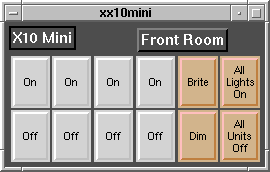 X-10 Remote Control
X-10 Remote Control
 X-10 Remote Control
X-10 Remote Control
The daemons consist of the client interface daemon and a reader/writer child pair that interface to the hardware. Clients open a socket to x10d for processing of their requests. The current scheme is limited to the use of Unix Domain sockets. If a picture would help to understand this, here's one in postscript.
Among the existing clients for the rcDaemon package are xx10mini (shown at top of this page) & xx10maxi (in development). These are based upon the Free Widget Foundation widget set. Also available are Motif based versions of the same controllers.
The current version uses either the FreeBSD X-10 driver, /dev/tw, or a serial-port based X-10 interface, the Serplix.
The FreeBSD tw device driver is a TW523/parallel port based driver.
The SerPlix box can send/receive all possible X-10 codes thru the 117 volt house wiring. It uses an ASIC chip sold by Micromint ( PLIX ) and the PowerHouse TW523 X-10 powerline interface module. The schematic for the SerPlix is available as a dump in HP laserjet format in this file.
It should be fairly simple to port the reader/writer daemons to use other commercially available X-10 computer-based controllers.
PLIX is a trademark of Micromint, Inc.
Radio Shack and Plug 'n Power are trademarks of Tandy Corp.